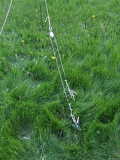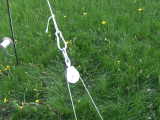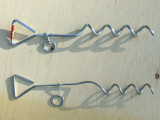
I got this idea to increase the holding power of those corkscrew-style "dog stakes" (found in pet supplies) by combining two together. The pulley and cable enables it to remain effective even if the wind changes direction. Part of the inspiration came from a scheme for a cascaded kite bridle.
The stakes aren't fully screwed into the ground for these photos, because the grass would obscure parts of the stake. For this scheme to work well, it's best to keep the two stakes fairly close together. I'm putting them a foot or so apart, for 8 feet of cable.
If the stakes are too far apart, the kite gets a mechanical advantage. Imagine pulling down or sideways on a clothesline - it's easy to rip out the anchor bolts or snap the clothesline.

Here I've simulated an 80 degree change in the wind direction. Any pull on the pulley is still distributed equally to the two stakes. If the flying line's angle above ground is high enough, it should easily pass over the downwind stake, and be able to turn completely backwards.
That's also partly why I like spiral dog stakes. They don't care what direction you pull in, they won't slip out easily, unlike a tent peg driven in at an angle.

Detail of the pulley section. The carabiner is optional, you could use any connection scheme you want. The link between the carabiner and the pulley is permanent part of the assembly, and has a threaded closure for more strength (compared to most inexpensive carabiners). It's rated at 880 pounds. The pulley itself is only rated for something like 480 pounds, but that can easily be upgraded in the future. It has a spring clip to retain the removeable pulley axle.
Detail of one of the ends of the cable. The cable is 1/8" inch twisted steel, rated for 1200 pounds. I can't say for sure what force the three clamp fasteners can take.


